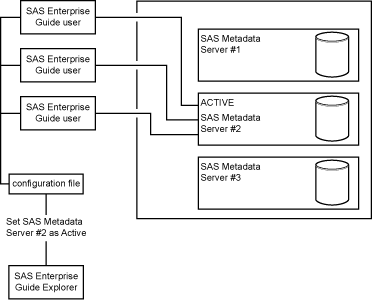What Is a Metadata Server?
A metadata
server contains definitions for objects such as workspace servers
and libraries that are used by SAS Enterprise Guide and other applications.
Metadata definitions in a SAS Metadata Server can be used by many
other applications besides SAS Enterprise Guide, which enables you
to use a single set of object definitions for all SAS applications
in your organization.
You can use SAS Enterprise
Guide Explorer to define libraries in a SAS Metadata Server. Other
metadata definitions (such as servers, users, and SAS content) are
defined by SAS Management Console or other applications such as SAS
Data Integration Studio.
Setting up metadata
servers is an essential part of SAS Enterprise Guide administration
because SAS Enterprise Guide needs to access at least one metadata
source, whether it is local or on a network server, in order to access
and share metadata definitions.
If you are using SAS
Enterprise Guide only with a local SAS server, you do not need to
install and configure a metadata server. You will be able to access
the SAS files and SAS Enterprise Guide projects on your local machine,
but you will not be able to define libraries or share SAS resources.
You can use SAS Enterprise
Guide Explorer to create profiles for multiple metadata servers, and
then select one profile as the active profile. SAS Enterprise Guide
then uses the server that is identified by the active profile as the
source for object definitions. You can change which profile is designated
as the active profile, but you cannot share object definitions between
profiles.
Repository Configuration, Active SAS Metadata Repository is an example of a multi-repository configuration that
is used with SAS Enterprise Guide, with a SAS Metadata Repository
selected as the active repository. This specifies
that SAS Enterprise Guide uses the selected SAS Metadata Repository
for object definitions.
After you set up the
profile configuration, you can use the automatic update feature to
make changes to the configuration and apply the changes automatically
to all machines where SAS Enterprise Guide is installed. You first
use SAS Enterprise Guide Explorer to make changes to the configuration,
including defining all profiles and designating the active profile.
The new configuration information is then saved to a file in a network
location. When a SAS Enterprise Guide user starts the application,
the configuration file is automatically read and the profile changes
are applied.
Profile Changes Applied through Configuration File shows how the changes to the profile configuration are
applied to SAS Enterprise Guide through the configuration file.

